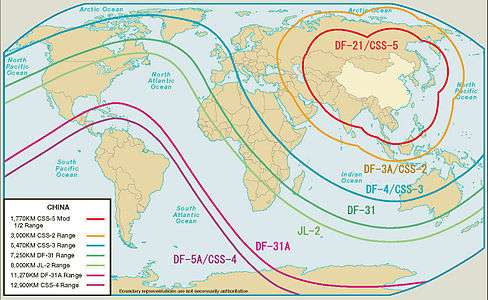DF-31
The Dong Feng 31 (simplified Chinese: 东风-31; traditional Chinese: 東風-31; lit.: 'East Wind-31'; NATO reporting name CSS-10)[5] is a third-generation long-range, road-mobile, three stage, solid-fuel rocket intercontinental ballistic missile (ICBM) in the Dongfeng missile series developed by the People's Republic of China. It is designed to carry a single 1-megaton thermonuclear weapon. It is a land-based variant of the submarine-launched JL-2. It is operated by the Second Artillery Corps (SAC) which, in 2009, was estimated to have under 15 DF-31 missiles and under 15 DF-31A missiles in inventory.[6] US Air Force National Air and Space Intelligence Center estimates that as of June 2017, five to ten Mod 1 and over fifteen Mod 2 launchers were operationally deployed.[7]
| DF-31 (CSS-10) | |
|---|---|
 DF-31 in Military Museum of the Chinese People's Revolution | |
| Type | Intercontinental ballistic missile |
| Place of origin | People's Republic of China |
| Service history | |
| In service | 2006 (DF-31), 2007 (DF-31A), 2017 (DF-31B) |
| Used by | People's Liberation Army Rocket Force |
| Production history | |
| Manufacturer | Academy of Rocket Motors Technology (ARMT) |
| Specifications | |
| Mass | 42 t (41 long tons; 46 short tons) |
| Length | 13 m (42 ft 8 in) |
| Diameter | 2.25 m (7 ft 5 in) |
| Warhead | 1 Thermonuclear weapon@ 1 Mt with decoys (DF-31 & DF-31A) 3-5 Nuclear @ 20, 90, or 150 kt each with MIRV (DF-31B) [1] |
| Engine | Solid-fuel rocket |
Operational range | 7,200–8,000 km (4,500–5,000 mi) (DF-31)[2][3] 11,200 km (7,000 mi) (DF-31A)[3] |
| Flight altitude | up to 1200 km |
| Maximum speed | Up to 8 km/s |
Guidance system | Astro-inertial guidance with BeiDou Navigation Satellite System |
| Accuracy | 100 m CEP for silo launched and 150 m for TEL-launched.[4] |
Launch platform | Silo, 8 axle TEL |

History
The PRC began developing the DF-31 ICBM in January 1985.[8] ARMT (then called the 4th Aerospace Academy) was appointed as the main contractor while the research arm of the Second Artillery Corps provided contributing support. The land-based variant of the JL-2 was originally called the DF-23 but was changed later on to the DF-31 because of a change in operational requirements. In 1999, the missile was first displayed publicly at the National Day Parade.[9] On August 2, 1999, the Chinese state news media reported the successful test of the DF-31.[8] The third test flight of the missile occurred on November 4, 2000; the second test flight had taken place earlier that year.[10] Operational deployment of the missiles reportedly began in 2006.[11] In 2009, US Air Force Intelligence reported that under 15 DF-31 missiles had been deployed.[6]
Description
The DF-31 is a three stage solid-fuel rocket equipped with an inertial navigation system. The missile is mounted on a transporter erector launcher. It is capable of reaching targets throughout Europe, Asia, and parts of Canada and the northwestern United States.[7]
DF-31A
The PRC has developed an improved variant of the DF-31 called the DF-31A. This upgraded missile has a reported range of 11,200 km,[3] will allow targeting of most of the continental United States[7] and was designed with MIRV capability to hold 3 to 5 warheads, each capable of a 20–150 kt yield, but is thought to be armed with only one warhead with penetration and decoy aids to complicate missile defense efforts.[1][1][6] The missile was shown to the public during the parade in Beijing celebrating 70 years since the end of World War II on September 3, 2015.[12] It can carry maneuverable reentry vehicles.[13]
DF-31AG/DF-31B
The PRC has developed an improved variant of the DF-31A called the DF-31AG (G stands for 改 (Gaï), "modified)[14] or DF-31B with an off-road 8 axle TEL and MIRVs.[15][16] China has successfully tested it from a mobile launcher.[17] The missile's TEL features an extra pair of elevators near the aft of the missile unlike the TELs of the DF-31 or DF-31A, suggesting a heavier missile second and third stage than earlier variants.[18] On the military parade marking the 90th Anniversary of the founding of the People’s Liberation Army in 2017, DF-31AG ICBM was officially demonstrated.[19]
References
- http://www.nti.org/media/pdfs/design_characteristics_of_chinas_ballistic_cruise_missile_inventory.pdf?_=1339613656
- CSS-10 (DF-31), missilethreat.csis.org
- Annual Report to Congress: Military Power of the People's Republic of China 2008, Office of the Secretary of Defense
- "Dong Feng 31 (DF-31/DF-31A/CSS-10)". Missile Threat.
- https://www.nasic.af.mil/LinkClick.aspx?fileticket=F2VLcKSmCTE%3D&portalid=19
- US Air Force Air and Space Intelligence Center, Ballistic and Cruise Missile Threats 2009
- http://www.nasic.af.mil/LinkClick.aspx?fileticket=F2VLcKSmCTE%3d&portalid=19
- Diamond, Howard (July 1, 1999). "Chinese Strategic Plans Move Forward with Missile Test". Arms Control Today. Arms Control Association. ISSN 0196-125X. Retrieved August 22, 2015 – via Questia Online Library.
- The Federation of American Scientists & The Natural Resources Defense Council (DF-31A) Nov, 2006. 73 (PDF)
- Gertz, Bill (December 13, 2000). "Pentagon Confirms China's Missile Test". The Washington Times. Retrieved August 22, 2015 – via Questia Online Library.
- Minnie Chan (23 January 2014). "China's nuclear missile drill seen as warning to US not to meddle in region". South China Morning Post. Retrieved 24 January 2014.
- WORLD TV (3 September 2015). "CHINA SHOWS OFF ITS MILITARY POWER ON V-DAY 70TH PARADE; Strategic Strikes Module Displays MISSILES" – via YouTube.
- Diplomat, Franz-Stefan Gady, The. "Here's What You Need to Know About China's Grand Military Parade". The Diplomat.
- KENHMANN, Henri (24 July 2017). "Qui est ce nouvel ICBM mobile DF-31AG ?".
- Minnie Chan (4 October 2014). "China puts on show of force with DF-31B mobile ICBM missile test". South China Morning Post. Retrieved 10 October 2014.
- China tests 10000 km nuclear missile 4. October 2014
- "China has successfully test-launch of DF-31B intercontinental ballistic missile from mobile launcher Archived 2015-04-02 at the Wayback Machine 19. March 2015
- http://www.janes.com/article/49693/evidence-emerges-of-possible-df-31-icbm-variant
- http://www.military-today.com/missiles/df_31ag.htm
Further reading
- Giacometti, Nicolas (10 April 2014). "China's Nuclear Modernization and the End of Nuclear Opacity". thediplomat.com. Retrieved 12 April 2014.